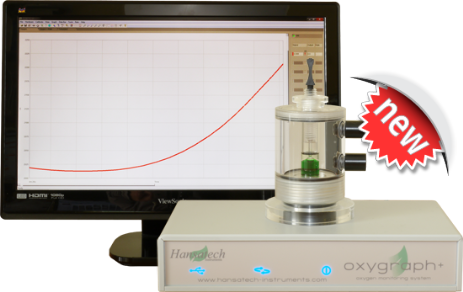OXYGRAPH PLUS - GMR STRUMENTI
Menu principale:
MISURA OSSIGENO > Ossigrafi fase liquida

OXYGRAPH PLUS - HANSATECH
- PC operated oxygen electrode control unit with USB2.0 connectivity
- Suitable for liquid & gas-phase samples with 0 – 100% oxygen concentration
- Clear cast acrylic DW1/AD oxygen electrode chamber with integral Clark type polarographic oxygen electrode
- Integral systems for measurement of pH & other ion-selective electrode signals with 16 bit resolution
- 24 bit high resolution measurement of oxygen signals removes the requirement for gain & back-off settings
- System expansion to 8 channels via purchase of additional components
- Windows® software for data acquisition, hardware control & data analysis
- Real time 0 – 4.5v analogue output of oxygen electrode signal
The Oxygraph Plus oxygen electrode system provides PC control of oxygen uptake or evolution measurements across a broad range of applications from studies of mitochondria and cellular respiration to measurements of isolated chloroplast suspensions in photosynthesis research applications with up to 100% oxygen concentration.
The Oxygraph Plus system consists of a highly sensitive S1 Clark Type polarographic oxygen electrode disc mounted within a DW1/AD electrode chamber and connected to the new Oxygraph Plus electrode control unit. The DW1/AD provides a highly versatile solution to measurements of dissolved oxygen in liquid-phase samples of between 0.2 – 2.5ml with it’s clear cast acrylic construction providing excellent sample visibility & uniform illumination. Precise temperature control of the sample and electrode disc can be achieved by connecting the water jacket of the DW1/AD to a thermoregulated circulating water bath.
Oxygraph Plus Electrode Control Unit
The next generation Oxygraph Plus oxygen electrode control unit combines striking aesthetics with enhanced features and functionality offering significant advances in functionality and performance over previous generations of electrode control units.
In conjunction with user-friendly O2view data acquisition and system configuration software, the Oxygraph Plus electrode control unit provides an effective tool for the measurement of oxygen signals from the S1 Clark type electrode disc mounted in one of a range of liquid and gas-phase oxygen electrode chambers with quick and easy system calibration and configuration. In addition, Oxygraph Plus is equipped with integral systems to allow the calibration and simultaneous measurement of either a pH or other ion-selective electrode (ISE) signal e.g. Ca+, TPP+ or an auxiliary input signal.
The Oxygraph Plus electrode control unit communicates with the PC via USB2.0 representing a significant advantage over the older RS232 serial communications and the well-known associated difficulties of using RS232 – USB adapters. Oxygraph Plus control units may be configured as single or multi-channel systems of up to 8 units allowing comparative measurements of multiple samples to be made conveniently and effectively. Multiple control units connect to a powered USB2.0 hub which is in turn connected to an available USB2.0 port of a Windows® PC.
Oxygraph Plus is designed with state-of-the-art electronics providing 24 bit high resolution for oxygen measurements with 16 bit resolution for ISE and auxiliary input signals. This significant development removes the requirement for gain and back-off associated with previous generations of control unit and also renders overscale problems obsolete. A 0 – 4.5V analogue output is fitted to the rear of the control unit allowing real-time output of the oxygen electrode signal to external recording/logging devices.
As with legacy oxygen electrode control units, Oxygraph Plus features an integral magnetic stirrer and all the electronics required to control and measure the signal from connected electrodes and is compatible with all existing liquid and gas-phase Hansatech oxygen electrode chambers and accessories.
